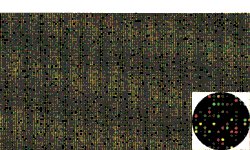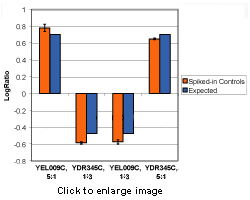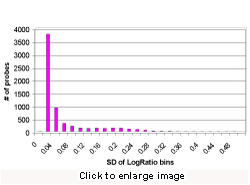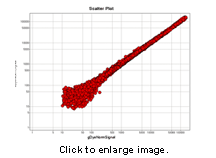Agilent 60-mer Oligo Microarrays
Accelerating real progress with industry-first 60-mer oligo microarrays
Agilent helped fuel the early growth of microarrays by unleashing the power of arrays with the Agilent GeneArray scanner (launched as the HP GeneArray scanner in 1997) that offered enhanced resolution allowing the design of denser arrays. Over the years, Agilent capitalized on its printing know-how and ability to industrialize new technologies that came naturally from our Hewlett-Packard roots. Agilent is proud to bring all of this together to offer industry-first 60-mer oligo microarrays in a commercial, easy-to-access format.
Agilent’s 60-mer oligo microarray design emerged from in-depth studies to identify a more reliable, less redundant probe layout format than those found in 25-mer designs. By optimizing probe design algorithms, services and validation methods, Agilent can offer highly-sensitive 60-mer oligo microarrays that consistently deliver accurate results, time after time, with improved up-to-date content and coverage.
Comprehensive Coverage
 A
typical hybridized oligo microarray containing 22,575 features.
A
typical hybridized oligo microarray containing 22,575 features.
|
Agilent's 60-mer oligo microarray format has been shown to deliver improvements in sensitivity with the ability to detect 1 transcript/cell/million cells. |
 Performance
control probes ensure log ratio accuracy within 1.4 fold of the expected log
ratio.
Performance
control probes ensure log ratio accuracy within 1.4 fold of the expected log
ratio.


Low noise leads to cleaner data and enhanced sensitivity as exemplified by
the typical results of a self vs. self hybridization on a single microarray.
Oligo microarrays have become the preferred platform for studying gene expression. Researchers worldwide want access to high-quality oligo microarrays and Agilent is poised to provide a steady stream of high-content, comprehensive microarrays with better quality and performance delivered through Agilent’s 60-mer oligo format. These microarrays are fabricated with Agilent’s SurePrint technology featuring industrialized inkjet in situ oligonucleotide probe synthesis to print microarrays on-demand, with great precision-backed by extensive manufacturing QC processes.
Agilent is the market leader in providing in an open/flexible microarray-based gene expression system build on the industry-standard 1” x 3” (25mm x 75mm) glass slide format. This provides scalability and choice for researchers. They can run Agilent microarrays on existing glass slide scanners as well as Agilent’s DNA microarray scanner. All of Agilent’s microarrays have been optimized to run on Agilent’s complete gene expression analysis system, so researchers can rest assured that they can easily add new components should the need arise.